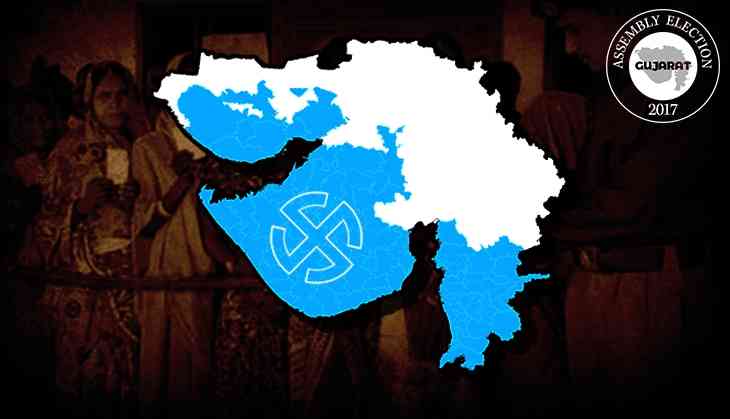Gujarat polls: Congress needs to improve its tally manifold in Phase 1

The Congress will have to improve its tally drastically in the seats that go to poll in the first phase of the Gujarat elections on December 9. Congress had fared poorly in these 89 seats in South Gujarat and Saurashtra in the last Assembly elections, managing to win only 16 seats.
Both these regions are politically significant and have been very volatile in the last three years. Of these, Saurashtra with 48 seats accounts for the largest number of seats in the 182 seat Gujarat Assembly, while South Gujarat sends 35 MLAs to the Assembly, Kachchh sends 6. These areas have a substantial Patidar or Patel presence and this is the community that is playing a pivotal role in these polls after having been a Bharatiya Janata Party (BJP) vote bank for more than two decades.
The voters from this community stand divided this time with the youth rallying around Patel leader Hardik Patel who has stood up to the Narendra Modi-Amit Shah combination in Gujarat on the issue of reservation in government jobs and educational institutions.
None of the parties can afford to ignore the Patels in these regions and this is evident from the fact that the community candidates have bagged maximum tickets from both the BJP and the Congress. Till the last date of the filing of nominations on Tuesday, the BJP had fielded 31 Patels on the total 89 seats while the Congress gave tickets to the community candidates on 27 seats.
The BJP has then gone on to field 21 candidates from the Other Backward Castes (OBCs), 15 from upper castes, 14 tribal candidates and eight Dalits. The Congress on the other hand has given 27 tickets to the OBCs, nine upper castes, 14 to the tribal candidates and the remaining nine to Dalits and Muslims.
There are 24 seats where Patidars are pitted against rivals from their own community and the same is the case for the OBCs on 18 seats.
For this phase of the polls, the BJP has played relatively safe, repeating 39 candidates. It has denied tickets to 29 sitting MLAs and three ministers. It has also fielded two candidates who have come over from the the Congress. The 32 seats where the BJP has changed its candidates are the ones where its previous candidates had won on last two occasions or more and carried the baggage of anti-incumbency.
Looking desperately to improve its performance in this phase of the polls, the Congress has repeated only 16 candidates.
The last date for withdrawal of candidature is November 24.
Surat district with 16 Assembly constituencies has witnessed a deluge of candidatures with 410 persons throwing their hat in the ring. Of these, 48 candidates have filed their nominations for the Limbayat seat alone. It remains to be seen how many of them finally remain in the contest after the withdrawal.
Regional variations
If one analyses the two regions separately, different issues play a dominant role in them. Saurashtra with its vast rural landscape will be voting on issues related to the farmers, its labour that works in the diamond and textile units in Surat that has been badly hit by demonetisation, the shoddy implementation of the Goods and Services Tax (GST) and also on issues pertaining to the industry in Rajkot and Jamnagar.
In South Gujarat, Surat district will be the nerve centre as it accounts for 16 of the total 35 seats. These seats include ones in Varaccha and Surat city that have witnessed massive protests from traders on demonetisation and GST. Around Surat, there are areas which are backward in terms of health and education and represent gaping holes in Narendra Modi's Gujarat Model.
There are also various industry related issues like environmental clearances, land availability, infrastructure for expansion in the belts of Ankleshwar and Vapi, where a large number of chemical and pharmaceutical units are located.
“There are also employment related concerns like ‘locals versus outsiders’. Land acquisition is a tedious exercise. There are concerns like water availability to the new industrial units. Many people want to establish new industrial units but it is difficult for them to meet all the criteria set by Gujarat Pollution Control Board,” points out senior political observer Harish Joshi who is based in Bharuch which happens to be the home turf of senior Congress leader Ahmed Patel.
Observers say that the Congress will have to improve its tally manifold in the first phase if it wants to improve its overall tally. “The party has shown political wisdom in the distribution of tickets. It is hoping to improve its tally in the rural areas of districts like Porbandar, Junagadh, Jamnagar, Gir Somnath and Dwarka in Saurashtra and Kachchh along with Surat, Vyara, Bharuch and Narmada in South Gujarat. It will be a big achievement for the party if it manages to break the BJP stronghold in the urban centres,” pointed an observer based in Ahmedabad. These include areas that are home turfs of senior Congress leaders like Arjun Modhwadia who is contesting from Porbandar and Shaktisinh Gohil, who hails from Bhavnagar but is contesting from Mandvi in Kachchh.
The polling in the first phase is expected to be the deciding factor in the outcome of the results on December 18. The question is how many of the seats will the BJP be able to regain in these two areas where it had virtually swept during the last polls.
First published: 22 November 2017, 17:14 IST

